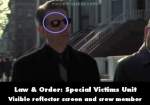Continuity mistake: Benson visits Stabler at his home to confronts him about the FBI detail he has ordered to protect her. They talk outside and then Benson is seen walking away. The next shot shows a side shot of Benson approaching him again in silence but mouthing words to him. (00:49:00)
Other mistake: Guest star Eric Stoltz is credited as Eric Stolitz.
Inheritance - S3-E8
Audio problem: Benson and Stabler are searching Darrel Guan's room. When Stabler picks up the bloodstained pants, Benson 'says', "blood" but her mouth doesn't move. (00:28:05)
Redemption - S3-E6
Visible crew/equipment: While Detective Stabler and Hawkins talk on the sidewalk, the shadow of a boom mic can be seen on Stabler's shoulder. (00:19:55)
Visible crew/equipment: As Benson and Stabler are interviewing the grandmother, the mirror behind Stabler briefly shows a microphone that peeks into view. (00:34:00)
Visible crew/equipment: As Benson and Stabler are walking along the sidewalk talking to the manager of the locksmith company, they pass by two red vans and stop in front of the second one. In the reflection of the van and the window there is a boom mic and a cameraman blatantly visible for more than 15 seconds. (00:18:05)
Visible crew/equipment: Benson and Stabler are arriving at Judge Thornburg's place of residence as they learn he's been shot. As their vehicle squeals to a stop, you can see multiple crew members and equipment in the reflection of their maroon car. (00:19:00)
Character mistake: Detective Stabler and ADA Cabot go to talk to Allen and Hannah Cooper in the courthouse, and Ottis Toole, the alleged murderer of Adam Walsh, comes up into the conversation. Stabler states that Toole died of AIDS on death row, when, in fact, Toole died of cirrhosis (liver damage). (00:27:15)
Visible crew/equipment: After Cragen and Cabot meet with and Mark Sanford and his attorney, Cragen storms out of the building, followed by Cabot. As the camera pans following them, you can see the reflection of a microphone in the reflection of the windows of the silver car in the foreground. (00:18:00)

Repression - S3-E1
Visible crew/equipment: A white reflector screen and a crew member are reflected on Munch's sunglasses when he is questioning the housekeeper. (00:30:20)





